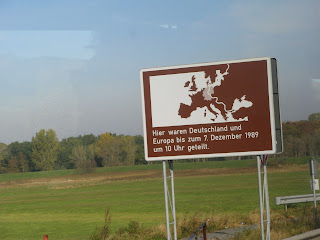"Germany and Europe were divided here until 10 am on December 7, 1989."
Yesterday was the USAC excursion to the former Inner-German Border. After an hour-long train ride from Lüneburg to Hitzacker, we boarded our coach bus. Driving through the countryside and the little villages, we saw many traditional Niedersachsenhäuser (Lower Saxony houses): half-timbered, red brick buildings (pictured below). Many roofs were decorated with horse heads, the symbol of Lower Saxony. Also, many of the houses had very large glass doors or windows, filling what used to be a gate into the house. Before modern heating, animals were brought inside to supplement the ever-present fire in warming the house.
Another common feature along our rural route were yellow "X"s, the symbol of protest against the transport and storage of nuclear waste in the area (pictured above). We were told that the train tracks we used are frequently blocked or sabotaged by protestors, especially when the waste is being transported to the storage facility (below). Police forces are brought from all of Germany to protect the train and the facility from likely sabotage. When we drove past the facility, even though nothing was going on, there was still a significant police presence.
Our first stop was in Dömitz, a small town on the east side of the River Elbe (in former East Germany) and the home of a fortress dating from the early 1500s. The fortress (German: Festung) was used in the Thirty Years' War and again during the Napoleonic Era. We were able to walk around inside and on top of the walls, which offered a good view of the town and the river. On one of the battlements there is an apple tree, which a couple guys climbed to pick fruit for everyone.
We didn't stay at the fortress for very long before we were off to lunch near the Dömitz harbor. Over schnitzel and locally-brewed raspberry sparkling lemonade, those at my table heard about our bus driver's service in the East German army. We even got to see his military identification card. I definitely didn't understand everything he told us, but I'm picking up on more and more as my German improves.
From Dömitz, we took the bus through the countryside (which, as I've said before, looks very much like the United States' Midwest) to Schnackenburg. There we visited the Grezlandmuseum (Border Region Museum), a small collection of military items from both sides of the once-divided Germany.
After some skillful driving to get our bus through road construction, we arrived at the memorial site for Stresow. First mentioned in the early 1300s, the town of Stresow was almost entirely destroyed by a fire in 1922, and completely rebuilt starting that same year. Unfortunately, the town was situated directly on the inner-German border. For a time, the residents could stay, but only with a special permit; they needed different permission to leave the town. Then, one night, the East German government decided that everyone needed to leave, and took everyone in Stresow from their beds into the East. All the buildings were then razed. Today, 16 oak trees grow at the memorial site, commemorating the 16 families who used to live in Stresow.
To avoid the construction on our way out, we took our bus along the East German patrol path, which was just as adventurous. Our final stop was a West German watch tower, evidence of the differences between the two sides. East German guards were in place to prevent people from crossing the border into the West. West German guards patrolled to watch for fugitives and help them reach safety. West Germany also posted watch towers along the border to keep an eye on the East's activities.
The patrol path wasn't designed for buses, but we made it work.
Arriving at the train station right on time, we said a big thank you to our bus driver and boarded the train back to Lüneburg. The former border, though officially gone, still divides the two sides of Germany. Germany's division left an impression on the two societies that can seen even today, in the architecture and even the personalities of those who grew up on a certain side of the line.













No comments:
Post a Comment